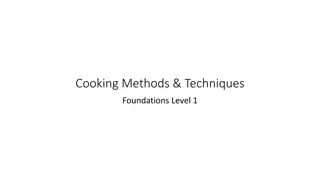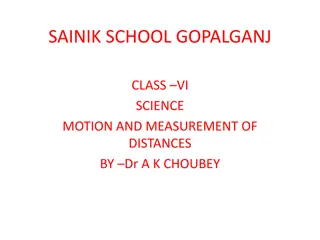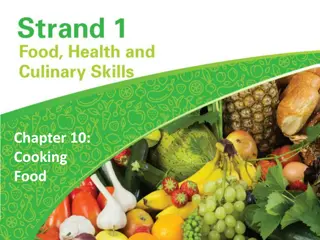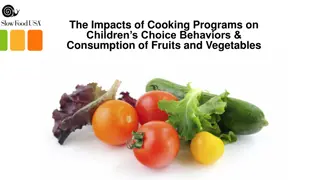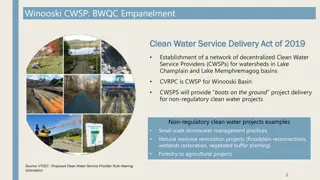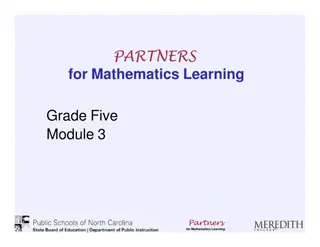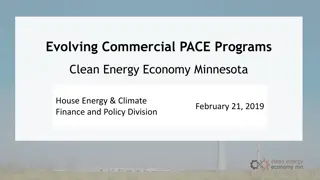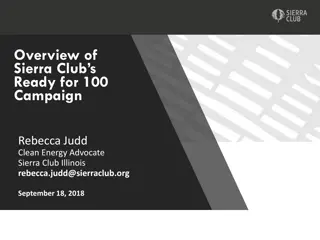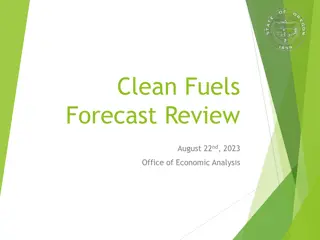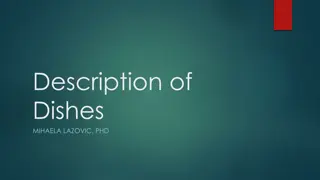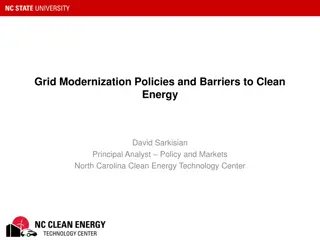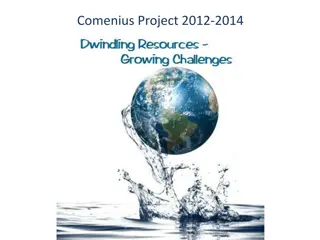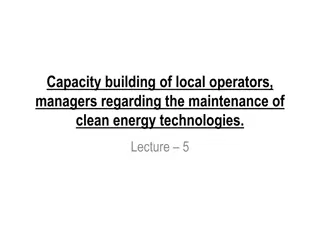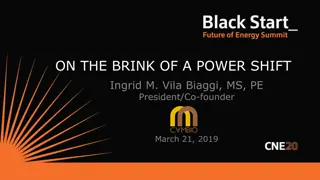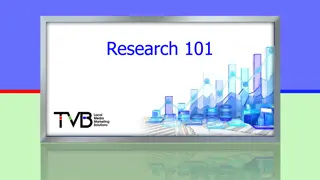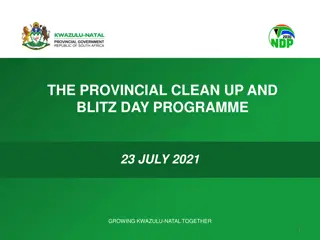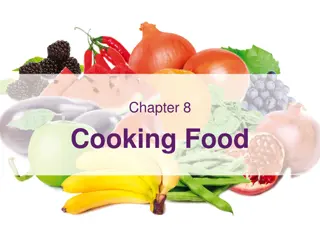Measurement of Social Impact Through Clean Cooking Solutions
Process for defining, measuring, and reporting on social impact objectives in the clean cooking sector, focusing on women's empowerment and livelihood creation. Key findings include the importance of time savings, livelihood measurements, and existing frameworks for measuring impact. Social impact monitoring and evaluation needed at three levels to capture the sector's global impact.
Download Presentation

Please find below an Image/Link to download the presentation.
The content on the website is provided AS IS for your information and personal use only. It may not be sold, licensed, or shared on other websites without obtaining consent from the author.If you encounter any issues during the download, it is possible that the publisher has removed the file from their server.
You are allowed to download the files provided on this website for personal or commercial use, subject to the condition that they are used lawfully. All files are the property of their respective owners.
The content on the website is provided AS IS for your information and personal use only. It may not be sold, licensed, or shared on other websites without obtaining consent from the author.
E N D
Presentation Transcript
Measurement of Social Impact Generated through Clean Cooking Solutions Allie Glinski Gender and Development Specialist International Center for Research on Women
Process for Defining, Measuring and Reporting on Social Impact Objectives: Gain consensus on the key and realistically measurable components and pathways through which the clean cooking sector creates social impact Create a collection of standardized indicators & measurement methodologies Create a centralized data capture, management, and analysis system Why? To allow partners to track and analyze progress To aggregate the social impact of the clean cooking sector at a global level How? ICRW Phase 1 Map and define relevant social impacts Select key domains of social impact for measurement Draft indicators Select/create measurement methodologies Develop a data capture and management system Pilot M&E system Modify and adjust Roll out 2| C L E A N C O O K S T O V E S A N D F U E L S
Key findings from initial mapping & literature review The Alliance has a specific interest in understanding and focusing on women s empowerment and livelihood creation, as both are core areas of the mission. Women s empowerment in particular has been loosely used in the sector and there is a need to clarify which social impacts actually lead to empowerment. Women s empowerment defined as the combination of increased access to resources and improved agency will likely be enhanced for women who are engaged in the clean cooking value chain When women are empowered through the clean cooking value chain, it can have a multiplier effect on adoption and use of clean cooking solutions There are robust livelihood measurements in other sectors that can be applied and adapted for the cooking sector. It is well established that one of the biggest impacts that adoption and use of clean cooking solutions has on women is through time saved However, the nuances of time shifts need to be considered in varying contexts What exactly women do with this new free time is not well understood It may be enough to know that women have more time what results from the activities they choose to do with that time, is a bit removed from the actual adoption and use of the clean cooking solution Less time spent collecting firewood means decreased vulnerability to safety risks and decreased drudgery Previously established measurement frameworks exist that we can build off of: Progress out of Poverty (PPI), W+ Standard, IRIS, Women s Empowerment in Agriculture (WEAI), Environment and Gender Index (EGI), Oxford Poverty and Human Development Initiative (OPHI) indicators, Gold Standard, Gender GEDI Index 3| C L E A N C O O K S T O V E S A N D F U E L S
Social Impact M&E Needed at Three Levels 1) Social impact conceptual framework for the sector overall telling a global story What information do we want from all partners to demonstrate the sector has a social impact? Suggestions include economic status of household/poverty reduction, time savings, livelihoods created. Potentially utilize Progress out of Poverty Index for poverty measurements. 2) Social impact M&E indicators, methodologies, and tools to measure and track a limited number of social impact areas at the enterprise/project level. Set of indicators & methodologies Guidance for implementation Results reporting and certification 3) Strategy for M&E deep dive impact evaluations in certain areas. Areas where specific impact evaluations are needed to fill data gaps and get a more robust picture. For example, the Alliance research studies looking at impact of adoption on households in areas of empowerment, time savings, education, decision-making, etc. 4| C L E A N C O O K S T O V E S A N D F U E L S
Social Impact Conceptual Framework: How involvement in the clean cooking supply chain translates to improvements in women s social and economic empowerment Components of Empowerment Outcomes of Empowerment Involvement of Women Women investors Employment Women SME owners & executives Income Women in selection & design of clean cooking products Agency Technical & business skills Adoption of clean cooking solutions Voice/ participation Multiplier Effect Women in production of clean fuels and/or stoves Business & social networks Status Decision-making & control over assets/ resources Women in distribution of clean fuels and/or stoves Knowledge of environmental/ health benefits Women in after-sales service of clean stoves Expanded access to capital/credit Financing options targeted to women as consumers Women as borrowers (supply-side) 5| C L E A N C O O K S T O V E S A N D F U E L S
Social Impact Conceptual Framework: How adoption and use of clean cooking solutions translates into improvements in households well-being & livelihoods Primary Outcomes Secondary Outcomes Ultimate Outcomes Money spent on fuel Shifts in Household Finances Increased financial security/income Money earned using clean cookstove/fuel Increased time spent on income- generating activities Increased time spent on informal, non-income generating activities Adoption and use of clean cooking solutions Time spent cooking Enhanced social and economic well-being Shifts in Time Use Increased time spent on leisure activities Time spent collecting fuel Increased time spent on education/ training (adult/children) Reduced drudgery (time & heaviness of load) Shifts in Workload Length/frequency of fuel collecting trips Enhanced safety/protection (reduced exposure to potential injury, GBV) Health benefits (reduced smoke exposure, lower rates of accidents/burns) Health benefits 6| C L E A N C O O K S T O V E S A N D F U E L S
Key Domains of Social Impact & Key Stakeholders Key Domains Key Stakeholders Livelihoods Time Household economics Well-being/quality of life Safety/protection Drudgery Investors Advocates Gender Experts Enterprises/ Implementers Others? (i.e. donors) 7| C L E A N C O O K S T O V E S A N D F U E L S
Key Domains of Impact: Livelihoods Key stakeholders Enterprises/ Implementer s X Key components Investors Advocates Gender Experts Jobs created X X X Income earned Quality of job Part-time/full-time Employee vs. entrepreneur Management level Stability of income Area within the value chain Sustainability of job Geographic location of job X X X X X X X X Control over resources/assets earned Acquisition of skills Technical skills Empowerment/leadership skills Access to networks X X Women-owned businesses X 8| C L E A N C O O K S T O V E S A N D F U E L S
Key Domains of Impact: Time Key stakeholders Key components Gender Experts Enterprises/ Implementers Investors Advocates Time spent on fuel collection X X X Time spent on cooking X X Full picture of time use Fuel processing Fire management Cleaning pots/kitchen How saved time is used Leisure Informal sector activities (e.g. childcare) Productive activities Education X X X X X X X X X X 9| C L E A N C O O K S T O V E S A N D F U E L S
Key Domains of Impact: Household Economics Key stakeholders Key components Gender Experts Enterprises/ Implementers Investors Advocates Money spent on fuel X X X X Income earned from cooking sector job Income earned from time saved from use of clean cooking solution How saved money is being spent How earned money is being spent Access to credit X X 10| C L E A N C O O K S T O V E S A N D F U E L S
Key Domains of Impact: Well-being/Quality of Life Key stakeholders Key components Gender Experts Enterprises/ Implementers Investors Advocates Sense of well-being X X X Perception of well-being Perception of benefits from clean cooking solution Perception of safety & risk Status in family, community X X X X Knowledge/ awareness of health and environmental benefits of clean cooking solutions 11| C L E A N C O O K S T O V E S A N D F U E L S
Key Domains of Impact: Safety/Protection Key stakeholders Key components Gender Experts Enterprises/ Implementers Investors Advocates Number of fuel collection trips X Time spend collecting fuel Physical injuries (e.g. splinters, animal attack, spinal injury) Safety of employees in work environment X X X Perception of safety & risk X X 12| C L E A N C O O K S T O V E S A N D F U E L S
Key Domains of Impact: Drudgery Key stakeholders Key components Gender Experts Enterprises/ Implementers Investors Advocates Distance traveled X X Heaviness of fuel load Labor intensive activities (scrubbing pots, processing fuel) All stakeholder groups agreed there is a need to continue to build the evidence that proves the theory of change for social impact. 13| C L E A N C O O K S T O V E S A N D F U E L S
Current State of Field of Social Impact Measurement 1. Time use Fuel collection time savings (self-reported, time use activity journals)- distance matters, not just quantity Cooking time- CCTs- but not time changes in fuel processing/fire management/stove maintenance/cleaning 2. Socioeconomic Jobs created (sometimes sex disaggregated) Income (employee salary data v. national averages/minimums) Microenterprises created Fuel cost savings (KPTs + national fuel cost surveys; qualitative before/after surveys) 3. Well-being/quality of life Reduced drudgery (self-reported weight and distance fuel burdens carried) Other perceived benefits (qualitative survey feedback) 14| C L E A N C O O K S T O V E S A N D F U E L S
Key Questions How nuanced of an understanding/measurement of time use is necessary to feel that we are accurately, yet feasibly tracking impacts on time use? Do we need to understand what women do with their saved time? Should decreases in injuries encountered during fuel collection be captured under social impact or health impacts Who will actually be motivated to collect or pay for collection of this data? How will we validate the data? How deep within their value chain will we expect enterprises to collect data? What are the main components of a quality livelihood that we will want to measure? What are some of the key gaps in the theory of change of how clean cooking solutions generate social impact? How could these be filled in with specific research studies? Who would fund such studies? 15| C L E A N C O O K S T O V E S A N D F U E L S
Collaboration with ISO Working Group Alliance process provides content to feed into ISO Working Group ISO Working Group validates Alliance process and provides input along the way ISO process helps identify international experts with a wide variety of expertise to engage in the process; Experts have their government s support to engage in the process ISO Working Group allows for alignment of social impact M&E guidance with global standards process 16| C L E A N C O O K S T O V E S A N D F U E L S



